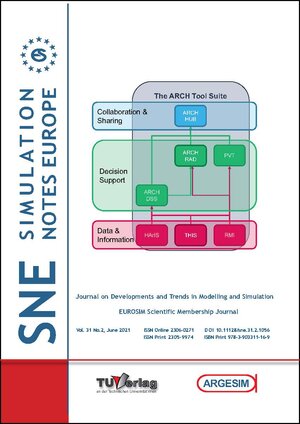
×
![Buchcover ISBN 9783903311169]()
Journal on Developments and Trends in Modelling and Simulation
EUROSIM Scientific Membership Journal
herausgegeben von Felix BreiteneckerKurzbeschreibung
EditorialDear Readers, This issue SNE 31(2) mainly publishes post-conference contributions from ASIM conferences and workshops –
showing the broad variety of classical simulation areas and looking into new areas.
The first contribution by D. Lückerath et al. introduces the ARCH project, with its goal of saving cultural heritage from climaterelated
and other hazards by means of data simulation – providing also the title graphic for this SNE issue.
The following two contributions are more of technical nature: F. Klabunde et al. make use of simulation for all-electric machines
and renewable electric power systems in agricultural operations, and R. Courant and J. Mass present an orthotropic non-hysteretic
permeability model as a lookup-table for FEA. The next two contributions deal with simulation software: P. Junglas combines
mealy behaviour and causality in NSA-DEVS, and P. Abele and M. Schäfer present SyNumSeS, a Python package for numerical
simulation of semiconductor devices. F. S. Pappert’s and O. Rose’s contribution addresses big data and simulation, by reducing
response time with data farming and machine learning. And the last Technical Note by L. V. Hanisch and M. Henke deals with the
unjustifiable poor cousin of simulation, with design of experiments – the authors investigate lifetime modelling of electrical machines
using the methodology of design of experiments
The last contribution is a Benchmark Note. In 2019, SNE has introduced extended possibilities for submitting a benchmark
contribution: i) a Benchmark Solution, ii) or a Benchmark Report, iii) or a Benchmark Study, differing in details and approach,
and in publication length. Additionally, content may concentrate on educational aspects (Educational Benchmark Note ‘BNE’),
and student authors may submit a benchmark contribution from their views (Student Benchmark Note - BNS). And so, a group of
master students has realised with ‘A Tutorial-oriented Approach to ARGESIM Benchmark C11 ‘SCARA Robot’ in MATLAB, Simulink
and Stateflow‘ an Educational Student Benchmark Note, from students for students, or as handout for exercise work.
I would like to thank all authors for their contribution, and thanks to the editorial board members for review and support, and
to the organizers of the EUROSIM conferences for co-operation in post-conference contributions. And many thanks to the SNE
Editorial Office for layout, typesetting, preparations for printing, electronic publishing, and much more.
And last but not least we are glad, that after the series of virtual conferences we can announce in this issue two EUROSIM
conferences as they used to be, MATHMOD 2022 and ASIM 2022 – Face-to-Face conferences in February 2022.
Felix Breitenecker, SNE Editor-in-Chief, eic@sne-journal. org; felix. breitenecker@tuwien. ac. at


